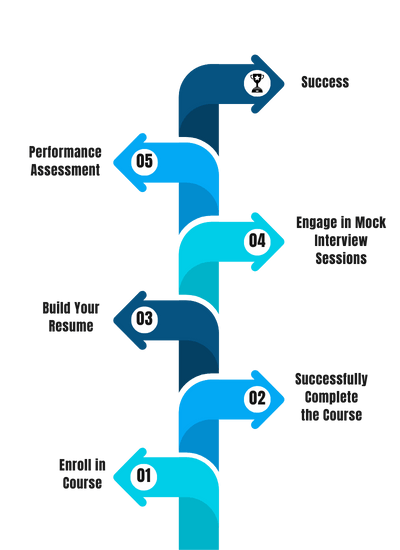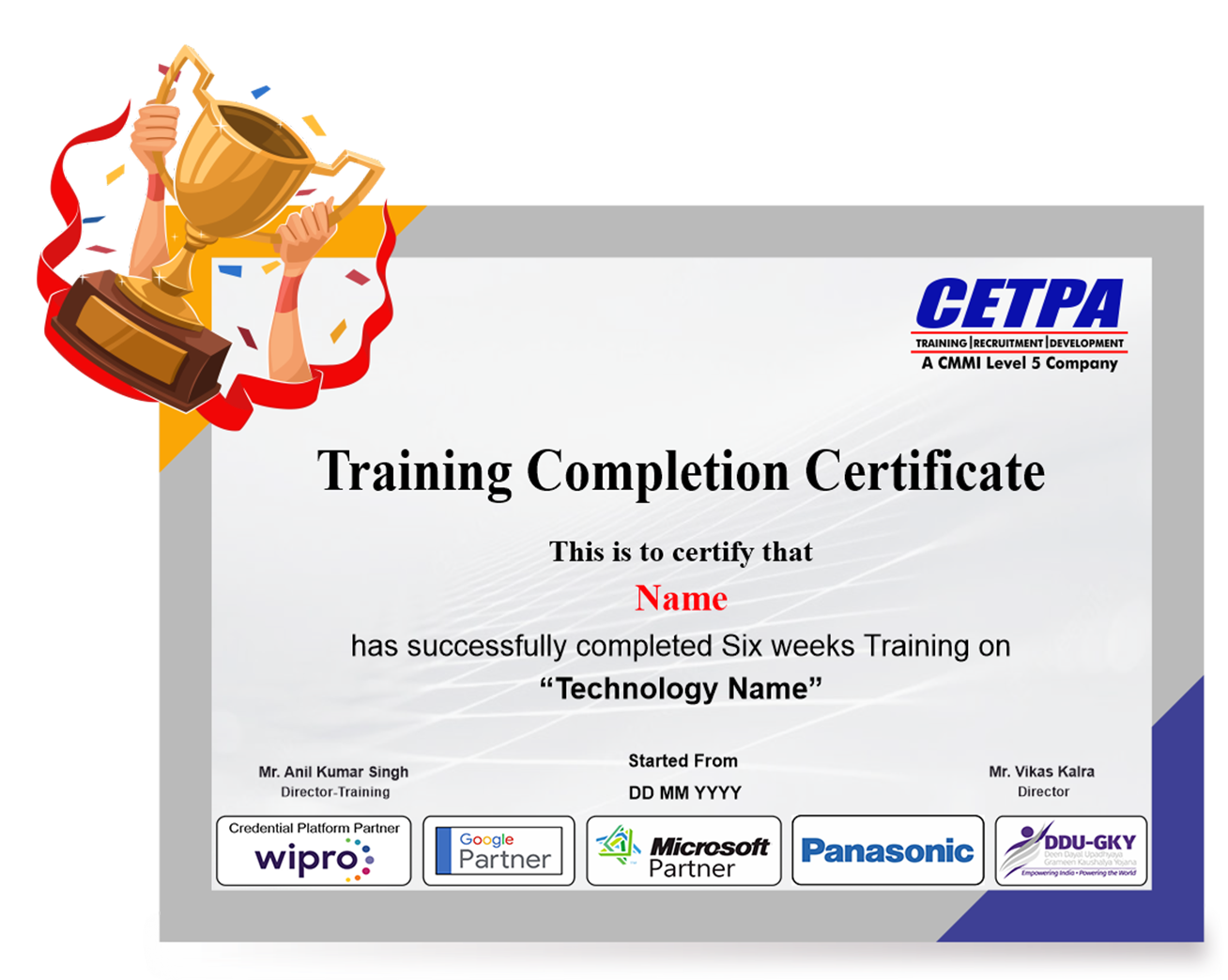CCNA With Cyber Security Certification Training
Discover the depths of CCNA With Cyber Security Technology. Join us now to gain comprehensive insights into CCNA With Cyber Security technology from a seasoned professional.
![]() 5 out of 5 based on 101 user reviews. |
5 out of 5 based on 101 user reviews. |  |
|  |
|  |
| 
Enquire Now
Accreditations & Affiliations
Training Features
Best Cyber Security Training Institute in Delhi NCR
Best Cyber Security Online Training in Delhi, Cyber Security Course in Noida, Cyber Security Training in Noida, Cyber Security Training Online, Cyber Security Full Course, Cyber Security Training in Delhi
CETPA Infotech delivers best cyber security training in Noida that helps to build fundamental and advanced cyber security techniques to master your product specific skills. Cyber Security means a set of methods used to protect systems, data, and network from cyber-attacks. Its main motive is to ensure a system’s reliability, integrity and privacy of data. There are many kinds of cyber-attacks such as malware, unpatched software, phishing, hacking and identity theft, hijacking files & many more.
Best Cyber security Course in Noida by CETPA is mainly designed for aspirants to meet the skill gap as per Industry demands. This training will make you well versed with the processes and practices followed for protecting networks and data from unauthorized attacks. It will also enable you to detect vulnerabilities of a system, ward off attacks and manage emergency situations. This course is suitable for
- Fresher’s
- Graduates
- IT Professionals
- Network Administrators/ System Admin/Information Security Officers & other professionals
There are number of reasons which make CETPA one of best Cyber security training in Noida. Some of them include-
- CETPA is the market leader in providing online training in different cutting edge technologies.
- Live Interactive training by Certified & industry expert Trainers
- This training offers it participants a complete overview of Cyber Security; basic as well as advanced.
- Enhances skills in Security threats and vulnerabilities
- Skills in security laws and standards
- Fast-track / Regular / Weekend Batches available
- Flexible Class Timings
- 1 Year Membership card
- World-class infrastructure with latest facilities
- Opportunity to work on real time projects.
- Internationally accepted and recognized certifications
- Assured Placement Assistance
CETPA, the best Cyber security Training institute in Noida provides Hands-on Training & lab sessions by Industry experts to gain knowledge to meet Industry Level skill gap. Learners will obtain knowledge in maintaining order and sustain high-level qualified workforce for securing critical systems and assets. Expertise mainly focuses on manual methodologies and tools with the main aim of imparting vital skills that are used to safeguard advanced security threats in critical IT infrastructures. State of art course materials is provided to the aspirants to leverage skills in each and every module of technology.
Our curriculum includes- Introduction to Cyber Security
- Networking Concepts Overview
- Security Management
- Network Security
- System security
- Data backup and recovery
- Secure data with encryption techniques
- Advantage of antimalware
- Internet security
- System and Application Security
- Security Certification by CETPA.
- You will get better knowledge of programming and how to implement it for actual development requirements in the industrial projects and applications.
- Enhanced knowledge on the web development framework. Using this framework, you can develop dynamic websites swiftly.
- You will learn how to design, develop, test, support and deploy desktop, custom web, and mobile applications.
- Design and improve testing and maintenance activities and procedures.
- Design, implement and develop important applications in a Cyber security environment.
- Increased chances of working in leading software companies like Infosys, Wipro, Amazon, TCS, IBM and many more.
Professional growth, increased compensation and validation of the skill are the most popular reasons why individuals and professionals seek IT certifications. Keeping this in mind, we at CETPA provide you with certification in latest and innovative technologies to help you to reach your certification goals.
CETPA is the official Training partner of Oracle, Microsoft, Autodesk, Panasonic and Nuvoton and thus provides Training as per international standards and curriculum. CETPA proudly provides you certification in association with our training partners so that you can validate your domain specific technical skills. Certification from these big brands will help you in grabbing your dream job.
- Gives you an advantage while searching for a job and provide a competitive advantage over your competitors.
- Ensure knowledge and skill are up to date and can be applied to the job
- Provide credibility to those looking for a career in an IT domain.
- Offer fast track to career advancement
- Demonstrate level of competency
- Professional Credibility as well as it demonstrates your dedication and motivation to professional development.
- You are likely to stand out from the crowd and be considered to be successful in your positions.
- Represent a well-recognized and valued IT credential that increases marketability and competitive edge.
- Provide peace of mind with the confidence that certified employees have truly learned the skills necessary to do their jobs;
- Express valuable credentials to search for in prospective employees, and can help retain top performers when offered as an incentive;
- Offer a competitive advantage when the team is trained and certified regularly.
Talk To Advisor
MODE/SCHEDULE OF TRAINING:
| Delivery Mode | Location | Course Duration | Schedule (New Batch Starting) |
|---|---|---|---|
| Classroom Training (Regular/ Weekend Batch) | *Noida/ *Roorkee/ *Dehradun | 4/6/12/24 Weeks | New Batch Wednesday/ Saturday |
| *Instructor-Led Online Training | Online | 40/60 Hours | Every Saturday or as per the need |
| *Virtual Online Training | Online | 40/60 Hours | 24x7 Anytime |
| College Campus Training | India or Abroad | 40/60 Hours | As per Client’s need |
| Corporate Training (Fly-a-Trainer) | Training in India or Abroad | As per need | Customized Course Schedule |
Course Content
1.0 COMMON SECURITY THREATS
- 1.1 Describe common security threats
- 1.1.a Common threats to the physical installation
- 1.1.b Mitigation methods for common network attacks
- 1.1.c Email-based threats
- 1.1.d Web-based attacks
- 1.1.e Mitigation methods for Worm, Virus, and Trojan Horse attacks
- 1.1.f Phases of a secure network lifecycle
- 1.1.g Security needs of a typical enterprise with a comprehensive security policy
- 1.1.h Mobile/remote security
- 1.1.i DLP
- 2.1 Implement security on Cisco routers
- 2.1.a CCP Security Audit feature
- 2.1.b CCP One-Step Lockdown feature
- 2.1.c Secure router access using strong encrypted passwords, and using IOS login enhancements, IPV6 security
- 2.1.d Multiple privilege levels
- 2.1.e Role-based CLI
- 2.1.f Cisco IOS image and configuration files
- 2.2 Describe securing the control, data and management plane
- 2.3 Describe CSM
- 2.4 Describe IPv4 to IPv6 transition
- 2.4.a Reasons for IPv6
- 2.4.b Understanding IPv6 addressing
- 2.4.c Assigning IPv6 addresses
- 2.4.d Routing considerations for IPv6
3.0 AAA ON CISCO DEVICES
- 3.1 Implement authentication, authorization, and accounting (AAA)
- 3.2 Describe TACACS+
- 3.3 Describe RADIUS
- 3.4 Describe AAA
- 3.4.a Authentication
- 3.4.b Authorization
- 3.4.c Accounting
- 3.5 Verify AAA functionality
4.0 IOS ACLS
- 4.1 Describe standard, extended, and named IP IOS ACLs to filter packets
- 4.1.a IPv4
- 4.1.b IPv6
- 4.1.c Object groups
- 4.1.d ACL operations
- 4.1.e Types of ACLs (dynamic, reflexive, time-based ACLs)
- 4.1.f ACL wild card masking
- 4.1.g Standard ACLs
- 4.1.h Extended ACLs
- 4.1.i Named ACLs
- 4.1.j VLSM
- 4.2 Describe considerations when building ACLs
- 4.2.a Sequencing of ACEs
- 4.2.b Modification of ACEs
- 4.3 Implement IP ACLs to mitigate threats in a network
- 4.3.a Filter IP traffic
- 4.3.b SNMP
- 4.3.c DDoS attacks
- 4.3.d CLI
- 4.3.e CCP
- 4.3.f IP ACLs to prevent IP spoofing
- 4.3.g VACLs
5.0 SECURE NETWORK MANAGEMENT AND REPORTING
- 5.1 Describe secure network management
- 5.1.a In-band
- 5.1.b Out of band
- 5.1.c Management protocols
- 5.1.d Management enclave
- 5.1.e Management plane
- 5.2 Implement secure network management
- 5.2.a SSH
- 5.2.b syslog
- 5.2.c SNMP
- 5.2.d NTP
- 5.2.e SCP
- 5.2.f CLI
- 5.2.g CCP
- 5.2.h SSL
6.0 COMMON LAYER 2 ATTACKS
- 6.1 Describe Layer 2 security using Cisco switches
- 6.1.a STP attacks
- 6.1.b ARP spoofing
- 6.1.c MAC spoofing
- 6.1.d CAM overflows
- 6.1.e CDP/LLDP
- 6.2 Describe VLAN Security
- 6.2.a Voice VLAN
- 6.2.b PVLAN
- 6.2.c VLAN hopping
- 6.2.d Native VLAN
- 6.3 Implement VLANs and trunking
- 6.3.a VLAN definition
- 6.3.b Grouping functions into VLANs
- 6.3.c Considering traffic source to destination paths
- 6.3.d Trunking
- 6.3.e Native VLAN
- 6.3.f VLAN trunking protocols
- 6.3.g Inter-VLAN routing
- 6.4 Implement Spanning Tree
- 6.4.a Potential issues with redundant switch topologies
- 6.4.b STP operations
- 6.4.c Resolving issues with STP
7.0 CISCO FIREWALL TECHNOLOGIES
- 7.1 Describe operational strengths and weaknesses of the different firewall technologies
- 7.1.a Proxy firewalls
- 7.1.b Packet and stateful packet
- 7.1.c Application firewall
- 7.1.d Personal firewall
- 7.2 Describe stateful firewalls
- 7.2.a Operations
- 7.3 Describe the types of NAT used in firewall technologies
- 7.3.a Static
- 7.3.b Dynamic
- 7.3.c PAT
- 7.4 Implement Zone Based Firewall using CCP
- 7.4.a Zone to zone
- 7.4.b Self zone
- 7.5 Implement the Cisco Adaptive Security Appliance (ASA)
- 7.5.a NAT
- 7.5.b ACL
- 7.5.c Default MPF
- 7.5.d Cisco ASA sec level
- 7.6 Implement NAT and PAT
- 7.6.a Functions of NAT, PAT, and NAT Overload
- 7.6.b Translating inside source addresses
- 7.6.c Overloading Inside
8.0 CISCO IPS
- 8.1 Describe IPS deployment considerations
- 8.1.a SPAN
- 8.1.b IPS product portfolio
- 8.1.c Placement
- 8.1.d Caveats
- 8.2 Describe IPS technologies
- 8.2.a Attack responses
- 8.2.b Monitoring options
- 8.2.c syslog
- 8.2.d SDEE
- 8.2.e Signature engines
- 8.2.f Signatures
- 8.2.g Global correlation and SIO
- 8.2.h Network-based
- 8.2.i Host-based
- 8.3 Configure Cisco IOS IPS using CCP
- 8.3.a Logging
- 8.3.b Signatures
9.0 VPN TECHNOLOGIES
- 9.1 Describe the different methods used in cryptography
- 9.1.a Symmetric
- 9.1.b Asymetric
- 9.1.c HMAC
- 9.1.d Message digest
- 9.1.e PKI
- 9.2 Describe VPN technologies
- 9.2.a IPsec
- 9.2.b SSL
- 9.3 Describe the building blocks of IPSec
- 9.3.a IKE
- 9.3.b ESP
- 9.3.c AH
- 9.3.d Tunnel mode
- 9.3.e Transport mode
- 9.4 Implement an IOS IPSec site-to-site VPN with pre-shared key authentication
- 9.4.a CCP
- 9.4.b CLI
- 9.5 Verify VPN operations
- 9.6 Implement SSL VPN using ASA device manager
- 9.6.a Clientless
- 9.6.b Any Connect
1. INTRODUCTION TO ETHICAL HACKING
- Information Security Overview
- Information Security Threats and Attack Vectors
- Top Information Security Attack Vectors
- Motives, Goals, and Objectives of Information Security Attacks
- Information Security Threats
- Information Warfare
- IPv6 Security Threats
- Hacking Concepts
- Hacking vs. Ethical Hacking
- Effects of Hacking on Business
- Who Is a Hacker?
- Hacker Classes
- Hacktivism
- Hacking Phases
- Types of Attacks
- Types of Attacks on a System
- Operating System Attacks
- Misconfiguration Attacks
- Application-Level Attacks
- Skills of an Ethical Hacker
- Defense in Depth
- Incident Management Process
- Information Security Policies
- Classification of Security Policies
- Structure and Contents of Security Policies
2. FOOTPRINTING AND RECONNAISSANCE
- ng Threats
- Footprinting through Search Engines
- Finding Company’s External and Internal URLs
- Mirroring Entire Website
- Website Mirroring Tools
- Extract Website Information from http://www.archive.org
- Monitoring Web Updates Using Website Watcher
- Finding Resources Using Google Advance Operator
- Google Hacking Tool: Google Hacking Database (GHDB)
- Google Hacking Tools
- WHOIS Footprinting
- WHOIS Lookup
- DNS Footprinting
- Extracting DNS Information
- DNS Interrogation Tools
- Network Footprinting
- Locate the Network Range
- Determine the Operating System
- Footprinting through Social Engineering
3. SCANNING NETWORKS
- Check for Live Systems
- Checking for Live Systems - ICMP Scanning
- Ping Sweep
- Check for Open Ports
- Scanning Tool: Nmap
- Hping2 / Hping3
- Scanning Techniques
- Scanning Tool: NetScan Tools Pro
- Scanning Tools
- Do Not Scan These IP Addresses (Unless you want to get into trouble)
- Port Scanning Countermeasures
- Banner Grabbing Countermeasures: Disabling or Changing Banner
- Hiding File Extensions from Web Pages
- Scan for Vulnerability
- Proxy Servers
- Why Attackers Use Proxy Servers?
- Use of Proxies for Attack
4. ENUMERATION
- What is Enumeration?
- Techniques for Enumeration
- Services and Ports to Enumerate
- NetBIOS Enumeration
- NetBIOS Enumeration
- NetBIOS Enumeration Tool: SuperScan
- NetBIOS Enumeration Tool: Hyena
- NetBIOS Enumeration Tool:
- NetBIOS Enumeration Tool: NetBIOS Enumerator
- Enumerating User Accounts
5. SYSTEM HACKING
- Information at Hand Before System Hacking Stage
- System Hacking: Goals
- CEH Hacking Methodology (CHM)
- CEH System Hacking Steps
- CrackingPasswords
- Password Cracking
- Password Complexity
- Password Cracking Techniques
- Types of Password Attacks
- Distributed Network Attack
- Default Passwords
- Manual Password Cracking (Guessing)
- Stealing Passwords Using Keyloggers
- Spyware
- How to Defend Against Keyloggers
- Anti-Spywares
- What Is Steganography?
- Least Significant Bit Insertion
6. TROJANS AND BACKDOORS
- Trojan Concepts
- What is a Trojan?
- Trojan Infection
- Types of Trojans
- Command Shell Trojans
- Command Shell Trojan: Netcat
- GUI Trojan: MoSucker
- GUI Trojan: Jumper and Biodox
- Document Trojans
- E-mail Trojans
- E-mail Trojans: RemoteByMail
- Trojan Detection
- How to Detect Trojans
- Scanning for Suspicious Ports
- Trojan Horse Construction Kit
- Anti-Trojan Software
7. VIRUSES AND WORMS
- Virus and Worms Concepts
- Introduction to Viruses
- Virus and Worm Statistics
- Types of Viruses
- System or Boot Sector Viruses
- File and Multipartite Viruses
- Macro Viruses
- Cluster Viruses
- Stealth/Tunneling Viruses
- Encryption Viruses
- Polymorphic Code
- Computer Worms
- Malware Analysis
- Online Malware Testing: VirusTotal
- Online Malware Analysis Services
- Anti-virus Tools
8. SNIFFERS
- Sniffing Concepts
- Wiretapping
- Lawful Interception
- Packet Sniffing
- Sniffing Threats
- SPAN Port
- MAC Attacks
- MAC Flooding
- MAC Address/CAM Table
- How CAM Works
- DHCP Attacks
- How DHCP Works
- DHCP Request/Reply Messages
- IPv4 DHCP Packet Format
- ARP Poisoning
- What Is Address Resolution Protocol (ARP)?
- ARP Spoofing Techniques
- ARP Spoofing Attack
- Spoofing Attack
- Spoofing Attack Threats
- DNS Poisoning
- DNS Poisoning Techniques
9. SOCIAL ENGINEERING
- Social Engineering Concepts
- What is Social Engineering?
- Behaviors Vulnerable to Attacks
- Social Engineering Techniques
- Types of Social Engineering
- Human-based Social Engineering
- Technical Support Example
- Authority Support Example
- Social Networking Sites
- Social Engineering Through Impersonation on Social Networking Sites
- How to Detect Phishing Emails
- Anti-Phishing Toolbar: Netcraft
- Anti-Phishing Toolbar: PhishTank
- Identity Theft Countermeasures
10. DENIAL OF SERVICE
- DoS/DDoS Concepts
- What is a Denial of Service Attack?
- What Are Distributed Denial of Service Attacks?
- Symptoms of a DoS Attack
- DoS Attack Techniques
- Bandwidth Attacks
- Service Request Floods
- SYN Attack
- SYN Flooding
- ICMP Flood Attack
- Peer-to-Peer Attacks
- Permanent Denial-of-Service Attack
- Application Level Flood Attacks
- Botnet
- Botnet Propagation Technique
- DDoS Attack
- DDoS Attack Tool: LOIC
- DoS Attack Tools
11. SESSION HIJACKING
- Session Hijacking Concepts
- What is Session Hijacking?
- Dangers Posed by Hijacking
- Why Session Hijacking is Successful?
- Key Session Hijacking Techniques
- Brute Forcing Attack
- Network-level Session Hijacking
- The 3-Way Handshake
- Sequence Numbers
- Session Hijacking Tools
- Session Hijacking Tool: Zaproxy
- Session Hijacking Tool: Burp Suite
- Session Hijacking Tool: JHijack
- Session Hijacking Tools
12. HACKING WEBSERVERS
- Webserver Concepts
- Webserver Market Shares
- Open Source Webserver Architecture
- Attack Methodology
- Webserver Attack Methodology
- Webserver Attack Methodology:
- Webserver Attack Methodology: Webserver Footprinting
- Counter-measures
- Countermeasures: Patches and Updates
- Countermeasures: Protocols
- Countermeasures: Accounts
- Countermeasures: Files and Directories
- How to Defend Against Web Server Attacks
- How to Defend against HTTP Response Splitting and Web Cache Poisoning
- Web Server Penetration Testing
13. HACKING WEB APPLICATIONS
- Web App Concepts
- Web Application Security Statistics
- Introduction to Web Applications
- SQL Injection Attacks
- Command Injection Attacks
- Web App Hacking Methodology
- Footprint Web Infrastructure
- Footprint Web Infrastructure: Server Discovery
- Hacking Web Servers
- Web Server Hacking Tool: WebInspect
- Web Services Probing Attacks
- Web Service Attacks: SOAP Injection
- Web Service Attacks: XML Injection
- Web Services Parsing Attacks
- Web Service Attack Tool: soapUI
14. SQL INJECTION
- SQL Injection Concepts
- SQL Injection
- Scenario
- SQL Injection Threats
- What is SQL Injection?
- SQL Injection Attacks
- SQL Injection Detection
- Types of SQL Injection
- Simple SQL Injection Attack
- Union SQL Injection Example
- SQL Injection Error Based
- Blind SQL Injection
- What is Blind SQL Injection?
- SQL Injection Methodology
- Advanced SQL Injection
- Information Gathering
- Extracting Information through Error Messages
- Interacting with the FileSystem
- SQL Injection Tools
- SQL Injection Tools: BSQLHacker
- SQL Injection Tools: Marathon Tool
- SQL Injection Tools: SQL Power Injector
- SQL Injection Tools: Havij
- SQL Injection Tools
15. HACKING WIRELESS NETWORKS
- Wireless Concepts
- Wireless Networks
- Wi-Fi Networks at Home and Public Places
- Types of Wireless Networks
- Wireless Encryption
- Wireless Threats
- Wireless Threats: Access Control Attacks
- Wireless Threats: Integrity Attacks
- Footprint the Wireless Network
- Attackers Scanning for Wi-Fi Networks
- Bluetooth Hacking
- Bluetooth Threats
16. EVADING IDS, FIREWALLS, AND HONEYPOTS
- IDS, Firewall and Honeypot Concepts
- How IDS Works?
- Ways to Detect an Intrusion
- Denial-of-Service Attack (DoS)
- ASCII Shellcode
- Other Types of Evasion
- Evading Firewalls
- IP Address Spoofing
- Source Routing
- Website Surfing Sites
- Detecting Honeypots
- Detecting Honeypots
17. BUFFER OVERFLOW
- Buffer Overflow Concepts
- Buffer Overflow
- Shellcode
- No Operations (NOPs)
- Buffer Overflow Methodology
- Overflow using Format String
- Smashing the Stack
- Once the Stack is Smashed
- Buffer Overflow Security Tools
- BoF Security Tool: BufferShield
- BoF Security Tools
18. CRYPTOGRAPHY
- Cryptography Concepts
- Cryptography
- Types of Cryptography
- Government Access to Keys (GAK)
- Encryption Algorithms
- Ciphers
- Advanced Encryption Standard (AES)
- Public Key Infrastructure(PKI)
- Public Key Infrastructure (PKI)
- Certification Authorities
- Email Encryption
- Digital Signature
- SSL (Secure Sockets Layer)
- Transport Layer Security (TLS)
- Disk Encryption Tools
- Cryptanalysis Tool: CrypTool
- Cryptanalysis Tools
- Online MD5 Decryption Tool
19. PENETRATION TESTING
- Pen Testing Concepts
- Security Assessments
- Security Audit
- Vulnerability Assessment
- Limitations of Vulnerability Assessment
- Introduction to Penetration Testing
- Penetration Testing
- Why Penetration Testing?
- Testing Locations
- Types of Pen Testing
- Types of Penetration Testing
- External Penetration Testing
- Internal Security Assessment
- Black-box Penetration Testing
- Grey-box Penetration Testing
- White-box Penetration Testing
Our Process


FAQ'S
- Classroom Training
- Online Training
- Corporate Training
- On campus Training
Career Assistance
- Build an Impressive Resume
- Attend Mock-Up Interviews with Experts
- Get Interviews & Get Hired
Training Certification
Earn your certificate
Your certificate and skills are vital to the extent of jump-starting your career and giving you a chance to compete in a global space.
Share your achievement
Talk about it on Linkedin, Twitter, Facebook, boost your resume or frame it- tell your friend and colleagues about it.
Upcoming Batches
What People Say
Our Partners
Need Customized Curriculum? Request Now
Structure your learning and get a certificate to prove it.

Our Clients

Our Placed Students
Related Courses
Review Us
Akhilesh
![]() Wednesday, 10 October 2018
Wednesday, 10 October 2018
Best Cyber Security Training In Noida
I want to protect my business so i have joined Cyber security course where i have learned jow to protect my data from other sites, and protection from malware and also learned how to recover data . Best trainers and best Lab facility in Noida. Thanks CETPA
Course Features
- Lectures 0
- Quizzes 0
- Duration 10 weeks
- Skill level All levels
- Language English
- Students 0
- Assessments Yes































































